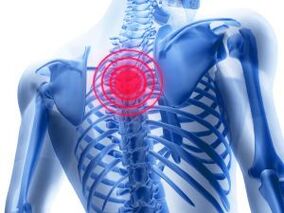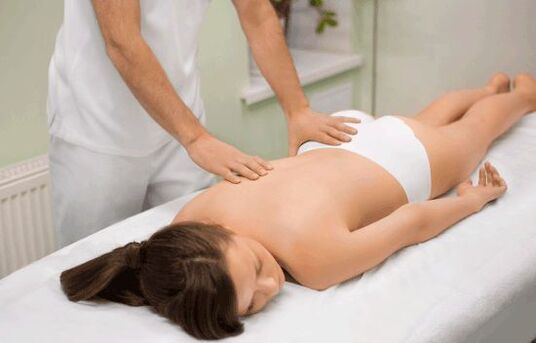
Clinically, thoracic osteochondrosis (chondrosis) manifests itself through acute, stabbing or dull, aching pain, crunching and clicking when bending, stiffness.
Symptoms characteristic and numerous specific for the pathology are a feeling of lack of air when inhaling, discomfort in the heart area and even a sore throat.
Treatment of the pathology is mostly conservative with pharmacological drugs. Physiotherapy procedures, massages and chiropractors are also used.
If such treatment is ineffective, the patient is shown surgery.
Details of the symptoms
Symptoms of thoracic osteochondrosis never appear all at once. At the initial stage of the development of this degenerative-dystrophic pathology, only slight back pain is noted. Patients take them after a hard day at work because of banal fatigue, the muscles write "numb" due to a long stay in one body position.
But the intensity of the complaints is slowly and steadily increasing. Unpleasant sensations are replaced by severe pain, which is made more difficult by restricted mobility, dizziness and headaches. In medicine, all symptoms of osteochondrosis of a given localization are divided into several groups. This will help diagnose it faster and determine treatment tactics.
On a note!Symptoms of thoracic osteochondrosis in men and women do not differ in character, severity, or location. In the stronger sex, however, they can arise a little later due to the stronger musculoskeletal system. Some men also have erectile dysfunction on a background of osteochondrosis.
Spinal symptoms
Under the influence of unfavorable factors (hypothermia, increased physical activity), long-term remission of thoracic osteochondrosis can be interrupted by a sudden acute attack of pain. It is more often provoked by staying in one body position for a long time, for example in a sitting position. When a person stands up abruptly, there is such severe pain in the back that they lose the ability to move for a few minutes.
In medicine, this condition is called dorsago. It differs from ordinary pain in that it has accompanying symptoms:
- a feeling of lack of air when inhaling;
- strong stiffness.
The course of the pathology is often complicated by dorsalgia - pain in the thoracic spine, the intensity of which gradually increases. It increases when you bend and turns the body to the sides. In order not to feel pain, a person takes a forced position. At the same time, it involuntarily strains the back muscles and involuntarily provokes their overexertion. Now they are starting to hurt too, especially when walking.
Extravertebral symptoms
When thoracic osteochondrosis develops, the intervertebral discs become thinner and destroyed. These cartilage pads can no longer distribute the stresses that occur and prevent the vertebrae from colliding with one another. A compensatory reaction of the body is triggered - bone structures begin to deform with the formation of growths. They press on sensitive nerve endings, injure the spinal canal. Therefore, there are specific symptoms of thoracic osteochondrosis in women and men: loss of sensitivity in certain parts of the body, burning sensation and creeping "goose bumps".
Important! Osteochondrosis of the thoracic localization often manifests itself in a dry, unproductive cough, sore throat, a feeling of coma and urinary tract diseases.
But that's not all. The roots of the spine are not only responsible for innervation (transmission of nerve impulses) in the spine, but also for the internal organs. Therefore, when they are injured, there are unpleasant sensations from the liver, kidneys, digestive tract and myocardium. What are the uncharacteristic signs of back pathologies manifested by thoracic osteochondrosis:
- Pain in the heart region, identical to the recurrence of angina pectoris, shortness of breath, a feeling of "compression" of the heart;
- Panic attacks, psychoemotional instability, unreasonable fear, anxiety, insomnia;
- discomfort in the epigastric region, fits of nausea, sometimes leading to vomiting, acid regurgitation, gas, boiling and rumbling;
- Peristalsis disorders - constipation or diarrhea;
- lingering, strained breaths with sobs.
The pain is not localized directly to the site of the destroyed intervertebral disc and (or) the herniated disc that has formed. They radiate along the course of the nerves. Signs of osteochondrosis of the chest region can be disguised as renal colic, symptoms of gastritis, peptic ulcer, hepatitis, pancreatitis, cholecystitis, and even gastroenteritis.
Compression myelopathy
This is the name of the extravertebral syndrome, which is rarely seen in clinical practice. It is observed in 3-4 stages of the disease, when the nucleus pulposus protrudes beyond the annulus fibrosus due to the loss of stability of the vertebral segment. An intervertebral hernia forms, which constantly presses on the spinal cord. At an appointment with a vertebrologist or neurologist, patients complain of frequent belt pain that radiates to the groin. At the same time there are feelings of weakness, numbness of the lower extremities.
Against the background of the injury to the spinal cord, the innervation is seriously disturbed. Without treatment, the functional activity of the organs located in the small pelvis decreases. Compression myelopathy causes problems with bowel movements. And due to the sharp narrowing of the diameter of the spinal canal, the sensitivity of the legs decreases. In severe cases, patients are diagnosed with paresis (partial or total paralysis) of one or two lower extremities.
Symptoms of remission
Outside of relapses, breast osteochondrosis almost does not bother a person. Occasionally there is aching, sore, dull back pain, which usually disappears after a long period of rest. However, it is worthwhile to increase the load on the spine, at least slightly, to lift a heavy object or to bend, as will follow the next time you relapse. It can be triggered by such factors:
- Stressful situations, depressive states;
- Hypothermia, sudden changes in temperature;
- prolonged stay in one body position;
- Alcohol abuse;
- unbalanced diet, lack of foods high in calcium, phosphorus, manganese, molybdenum in the diet.
Sometimes the remission period ends because a person is trying to avoid another relapse. He visits a chiropractor or masseur with a dubious reputation or little practical experience. An attempt to stretch the spine will result in another exacerbation.
The main treatment methods
It is not yet possible to completely cure the pathology, so all the efforts of doctors are aimed at improving the patient's well-being. Patients are recommended to wear orthopedic products (corsets, bandages) that fix the vertebral structures and prevent their displacement. Drugs of various clinical and pharmacological groups are prescribed, physical therapy measures and physical therapy exercises are carried out.

The movements of the chiropractor's hands are aimed at widening the gaps between the vertebrae, which decrease in thoracic osteochondrosis.
Important!With profound osteochondrosis of the breast, conservative treatment is useless. Surgical intervention is immediately offered to patients - removal of an intervertebral hernia, arthrodesis, insertion of implants in place of a damaged disc, bone grafting.
Drug therapy
Treatment of osteochondrosis of the thoracic spine is aimed at eliminating all symptoms, inhibiting destructive and degenerative processes. In phases of exacerbation, solutions for parenteral administration are used, which show an effect after 5-10 minutes. Then the result is strengthened by taking tablet preparations, applying ointments and gels. At the stage of remission, mainly external means are used, which have a more gentle effect on the body.
Nonsteroidal Anti-Inflammatory Drugs (NSAIDs)
This is the most widely used group of drugs in the complex treatment of osteochondrosis of the chest. Their active ingredients block the biosynthesis of pain, inflammation and fever mediators from arachidonic acids. Even after taking NSAIDs once, a person's well-being improves significantly:
- the severity of the pain syndrome decreases;
- the uncomfortable crunch that occurs when the body turns and tilts disappears;
- inflammatory processes in soft tissues weaken, edema dissolves;
- the range of motion in the chest area increases.
To stop relapses, intramuscular solutions are used. Preparations in capsules or tablets can cope with moderate pain. And ointments and gels quickly eliminate minor discomfort.
Preparations with B vitamins
Preparations with vitamins of group B cope well with disorders of innervation, improve the transmission of nerve impulses to the central and peripheral nervous systems, stimulate the restoration of damaged spinal roots. The composition of the funds is represented by thiamine, riboflavin, pyridoxine, cyanocobalamin.
In the first week of therapy, intramuscular administration of drugs is practiced, which, in addition to vitamins, contains lidocaine, which immediately eliminates pain. And then the patients are shown how to take pills for a month.
Glucocorticosteroids
The use of these synthetic analogs of hormones produced by the adrenal glands is practiced when safer means are ineffective. Glucocorticosteroids are prescribed to patients with acute, sharp back pain that radiates to the internal organs. The drugs can be taken orally, but much more often they are given parenterally, including in areas of broken intervertebral discs.
Glucocorticosteroids have a variety of contraindications and possible side effects. Long-term treatment of chondrosis of the thoracic spine with hormones leads to damage to the liver, kidney and stomach tissues. Therefore, their use is prohibited in patients with cirrhosis of the liver, gastric ulcer, kidney failure and osteoporosis.
Muscle relaxants
Back pain is often attributed to increased skeletal muscle tone. To relax it, muscle relaxants are used - first in the form of solutions for parenteral administration, and then in tablets. The drugs relieve muscle spasms that cause compression of the spine root. Which muscle relaxants are most effective:
- block polysynaptic reflexes;
- relaxing spasmodic muscles;
- Reducing the release of prostaglandins.
Drugs are rarely used as monotherapy. Treatment of chondrosis of the chest is with muscle relaxants in combination with glucocorticosteroids or non-steroidal anti-inflammatory drugs. Their main disadvantage is the rather rapid formation of addiction, so it is forbidden to use them for more than a week.
Chondroprotectors
Unlike drugs that eliminate symptoms of breast osteochondrosis, such drugs are also used for pathogenetic therapy. This is the only group of drugs that can increase the production of chondrocytes, which are necessary for the partial restoration of cartilaginous intervertebral discs. All therapeutic effects of chondroprotectors are due to the high content of glucosamine and / or chondroitin.
But chondroprotectors are not only valued for their ability to restore intervertebral discs. Its components glow in the area of the damaged vertebral segment. After 2-3 weeks, the maximum therapeutic concentration of glucosamine and chondroitin is reached. Now the drugs begin to show pronounced analgesic, anti-inflammatory and anti-edematous effects.
Recommendation!It is advisable to treat osteochondrosis with chondroprotectors in the form of injection solutions or tablets. Despite all the assurances given by the manufacturers about the effectiveness of ointments and creams, they were unable to provide any evidence for their therapeutic effectiveness.
Non-drug treatment
Treatment of osteochondrosis of the chest region with pharmacological drugs must necessarily be combined with regular physical education classes. Exercise therapy is the most effective therapy method to avoid disability. Daily training strengthens the muscular framework of the back and the ligament-tendon apparatus of the chest region, and the production of synovial fluid that supplies the vertebral structures is improved. The exercise set is determined by the physician of exercise therapy after studying the results of X-ray diagnostics. He is present in the first classes and monitors the dosage of the loads.
Manual therapy for osteochondrosis, which aims to enlarge the gaps between the intervertebral discs and vertebrae, is also practiced. Dry or underwater traction (traction) of the spine is carried out, and at home - hanging on the bar. The effectiveness of manual therapy increases with the simultaneous implementation of physiotherapy:
- Electrophoresis;
- Laser therapy;
- Magnetic therapy;
- UV radiation;
- diadynamic currents.
Patients are shown 10-15 sessions of classic, vacuum, Scandinavian acupressure. Hirudotherapy, acupuncture and spa treatments with radon and hydrogen sulfide baths are also helpful.
Only with the help of an integrated approach to the treatment of thoracic osteochondrosis is it possible to rule out further damage to the intervertebral discs and deformities of the vertebrae. Compliance with the recommendations of the doctor will help get rid of all symptoms of chronic pathology as soon as possible.














































